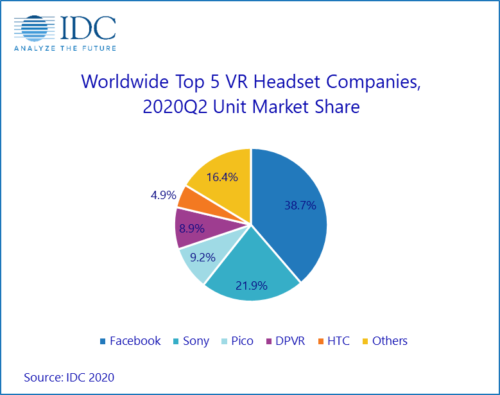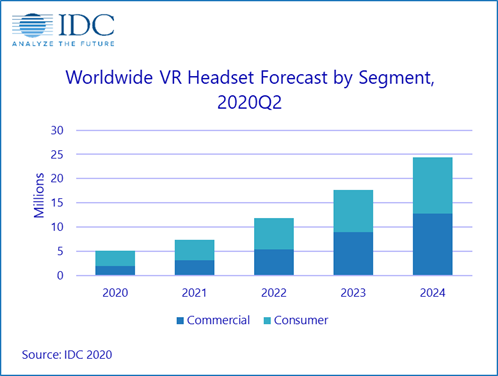VR headset market expected to grow despite short-term decline
Wednesday, September 16th, 2020
VR Headset Market Expected to Grow Despite Short-Term Decline, According to IDC
FRAMINGHAM, Mass. — As the world continues to deal with the pandemic, the market for virtual reality (VR) headsets is expected to decline 6.7% in 2020 before returning to double-digit growth of 46.2% in 2021, according to the International Data Corporation (IDC) Quarterly Augmented and Virtual Reality Headset Tracker. The market has faced a temporary setback this year as supply chain disruptions impacted volumes in the early months and expected product transitions have slowed the market mid-year. However, IDC expects shipments of VR headsets to grow rapidly with a compound annual growth rate (CAGR) of 48% from 2020 to 2024 as consumer and enterprise audiences continue to invest in the technology.

Virtual reality is starting to mature and reach a broader audience. “While gaming remains at the forefront of consumer VR, other use cases such as virtual concerts and virtual workouts are also starting to resonate with buyers,” said Jitesh Ubrani, research manager for IDC’s Mobile Device Trackers. “Meanwhile, many enterprises continue to ramp up their use of VR with training, collaboration, design, and manufacturing use cases driving momentum. We expect the commercial segment to grow from 38% of the worldwide market in 2020 to 53% by 2024.”
“We’re seeing increased interest in VR from both consumer and commercial buyers,” said Tom Mainelli, group vice president, Device & Consumer Research at IDC. “However, a confluence of events made for a tough first half of 2020 in terms of headset unit volumes, even as demand increased. We expect a sizeable increase in shipment volume during the second half of this year as production ramps up and new products launch into the market, and VR should see a return to robust growth in 2021.”

Category Highlights
Standalone VR declined as a category in the second quarter of 2020 (2Q20) despite growing awareness and high demand for headsets such as the Oculus Quest. Facebook finds itself in a precarious position. As the leader in the standalone category, the company’s share far exceeds that of every other player combined, though the recent discontinuation of the Oculus Go will likely lead to Facebook ceding some share at the entry level of standalone VR. Meanwhile, companies such as Pico, Lenovo, and others continue to court the enterprise market.
Tethered VR headsets also declined during the quarter although this was largely driven by the slowdown in PlaystationVR as consumers look forward to the next-generation Playstation console and a possible refresh of Sony’s popular VR headset. Other popular tethered headsets such as the Rift S and the HTC Vive family continued to see volume declines as both consumer and commercial buyers allocate spend in other areas this year. That said, there’s still a place in the market for tethered VR, which tends to drive a higher-quality visual experience than standalone products. Upcoming product launches such as HP’s new Reverb G2 should help drive a rebound in 2021.
Screenless Viewers have continued to decline in popularity and are mainly sold in emerging markets where local vendors try to attract first-time VR users with basic headsets that leverage the screen of their smartphone. However, the lack of content and toy-like experience prevents the category from achieving further success, and we expect volumes to continue to wind down through the forecast period.
Latest News
- Amagi report shows rise of a diverse global FAST marketplace
- Broadpeak to power targeted advertising on new TF1 video service
- AA/WARC reports UK 2023 ad spend at £36.6bn
- FCC restores net neutrality
- Five leading TV stations launch NextGen TV in Portland, Maine
- U.S. digital video ad spend growing ~80% faster than media overall